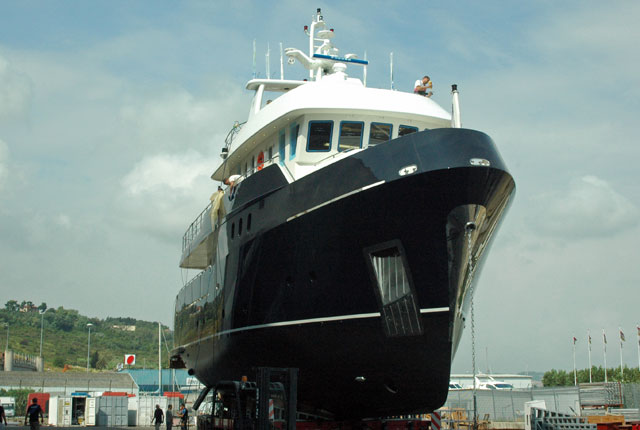Why would someone start a yacht-building business in the ongoing recession, given the soft megayacht market? Simple: research proving that buyers did exist, and that you could provide them with what they weren’t finding. That’s the story behind Cantiere delle Marche (pronounced “mark”), which opened its doors in 2010 in Ancona, Italy. It builds metal displacement yachts from about 66 to 148 feet (20 to 45 meters), engineered to cross oceans. A recent visit to the shipyard, where four projects are under construction, revealed why it’s successfully bucking the recession trend.
Cantiere delle Marche’s philosophy in approaching the tough market conditions came down to a familiar phrase. “It’s not the strongest, but the fittest,” says Vasco Buonpensiere, the sales and marketing director. He explains that the Cecchini family, who own the yard and who have a strong commercial-shipbuilding background, recognized that speedy, sexy, flybridge fiberglass yachts weren’t selling as strongly. They also recognized that the market was saturated with builders addressing that niche. Furthermore, Buonpensiere and the Cecchinis saw that “old money” owners and those who enjoyed far-flung cruising were still spending. Some builders targeted them, though mostly with production boats. The number of custom builders could be counted on one hand. Clearly, Buonpensiere and the Cecchinis believed, Cantiere delle Marche could tap the marketshare of buyers wanting fully custom yachts and megayachts with a go-anywhere, do-anything attitude.
Furthermore, Buonpensiere, who previously was the brand manager for CRN, and the Cecchinis discerned that lower fuel consumption, high quality, and value were of utmost importance to these buyers. Indeed, Buonpensiere shakes his head over how some owners accept less than they want. “This is the only industry in the world where a buyer says, ‘I know things are going to break in the first year to year and a half,’” he says. “You don’t buy a Bentley and say, ‘I know I’m going to get stuck on the highway.’” That’s why Cantiere delle Marche overbuilds, using 12mm steel plates vs. the 5mm classification standard. It also insists on cupronickel for pipes, vs. PVC, and independent rudders, like commercial ships. Even its radar masts (above) are entirely aluminum, laboriously welded into curves that buyers may not think are possible without fiberglass.
Sturdy expedition yachts still need to have creature comforts to attract buyers, however. “People want the quality, but still want something they can show off,” Buonpensiere says. Cantiere delle Marche’s Darwin series, to which last year’s launch Percheron belongs, reflects this, with family-friendly spaces. A Darwin 96 under construction at the yard will have a 900-bottle wine-stowage area. Buonpensiere adds that the Darwin 96 megayachts have about 15 percent more volume than similar boats. Another Cantiere delle Marche series, Nauta Air, has softer lines, plus a stronger connection to the outside via large windows.
“I’ve always slept well about what we’re doing,” Buonpensiere says. He’s not alone. Percheron’s crew noted that despite 60-knot winds and nearly 10-foot (3-meter) seas on one crossing, “nothing went wrong or got damaged.” Aboard their previous fiberglass boat, we would be seeking the nearest anchorage for safety, but not in the Darwin 86.”
For more information about the Darwin series, and its other yachts, directly from Cantiere delle Marche, fill out our contact form.











Leave a Reply